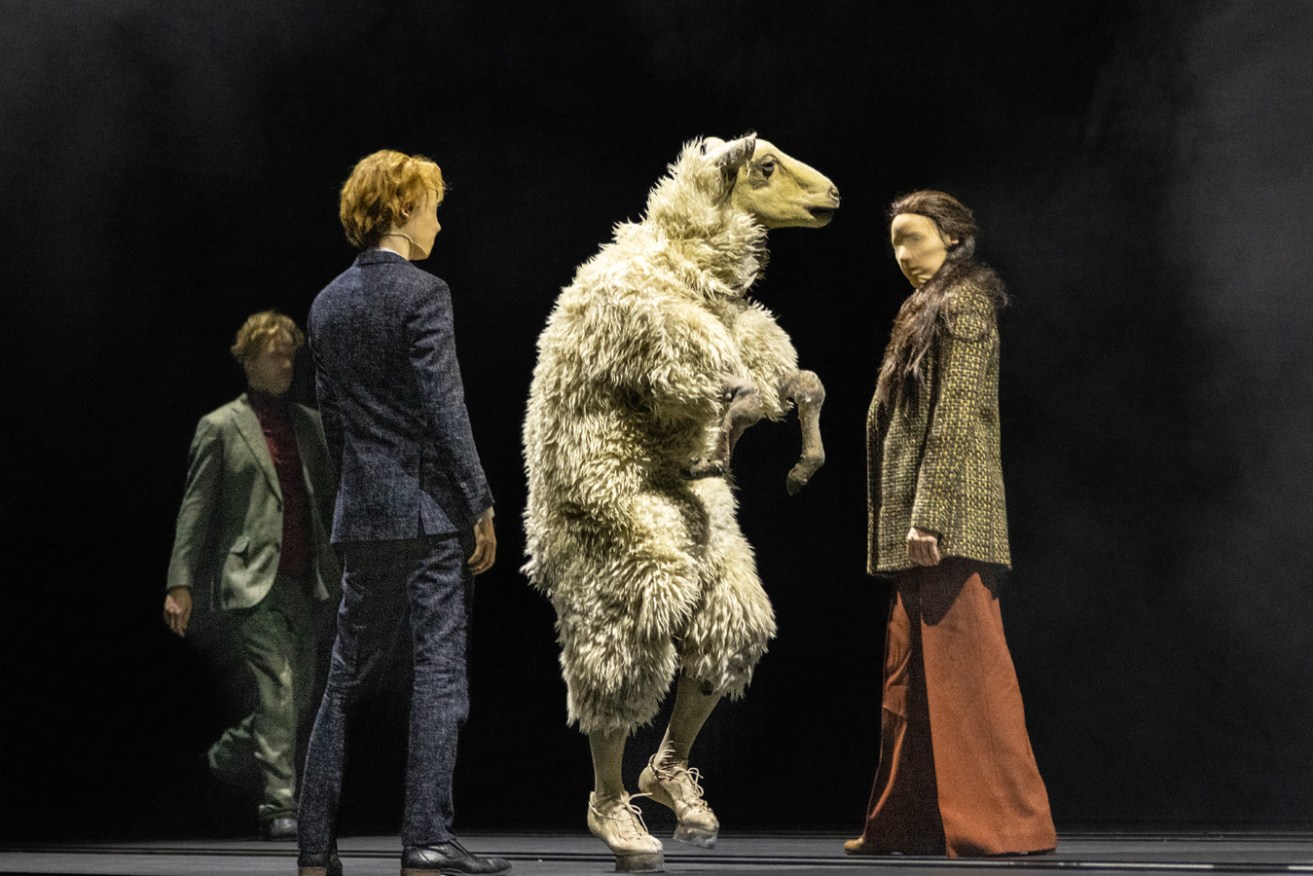Adelaide Festival review: The Sheep Song
The Sheep Song is a morality tale reminiscent of Aesop’s fables, depicting how a sheep’s ambition to become human sets it on a troubled journey. This charged quest is boldly presented with highly visual stagecraft.


FC Bergman’s 'The Sheep Song' is a wordless fable following the fortunes of an ambitious sheep. Photo: Tim Standing, Daylight Breaks
A striking beginning prompts nervous laughter from the audience, perhaps simply out of surprise as the curtain rises to reveal a small flock of real sheep. One of the woolly figures soon distinguishes itself by attempting to stand.
Here is the key character, a sheep that seeks more – and that goal is to become a different creature altogether; a human. Straight away, one aspect of the tale suggests itself: be careful what you wish for.
A cleverly depicted struggle to stand and walk is eventually successful as the particular sheep, with its previous flock carefully ushered backstage, now mingles with the human flock on a moving sidewalk while it tries to fit in.
The FC Bergman collective from Belgium has conceived significant and challenging original works before, often dealing with the little person lost in a big world. They typically develop these through a process of collecting and sequencing scenes built around a key idea. In The Sheep Song, those assembled scenes do not always form a cohesive storyline but embellish a core message and are visually impressive.
Fragmented moments comment on human foibles, often with historical weight, though having little direct association with the sheep. For instance, a small curtained Punch and Judy-type enclosure in the tradition of the Commedia Dell’Arte appears twice, featuring a Zeus-like monster god that manipulates a puppet through crude scenes of sexual desire before torturing it. In another interlude, a matador becomes the bull he has killed and is himself slain. The Way of the Cross is also suggested later. A blind woman does not react prejudicially towards the sheep and mates with it; the result is heartache and more isolation.
The sheep’s encounter with human language is represented by a flow of broken alphabetic characters that briefly merge and become legible so the audience can make out a phrase referring to game-playing. The sheep is none the wiser, still unable to comprehend human communication of this kind.
The sheep’s experiences are haunted by visits from a demonesque, naked man whose face is covered by a red cloth. This figure is generally supportive, which gives a strong clue to its connection with the sheep, one revealed at the play’s close.
A conveyor belt is ingeniously used throughout the performance, suggesting the sheep’s progress (or lack of), and the tension between attempts to move forward when so much is resisting. It’s a metaphor for much of life.
The central thread of the wordless play is adorned with a strong musical score (Frederik Leroux-Roels), dramatic lighting (Ken Hioco) and brilliantly conceived props. Titus De Voogdt is superb as the sheep, though it should be said that the collective claims acting is much less important than the concept at the heart of each work and its presentation.
Is there a different way to deal with the otherness of animals and address issues of difference between the human variety and the rest? Giving them properties we might have makes them more like us, but do we ever get it right? Cat and dog owners might say they do, having faith in their own abilities to interpret their pets’ behaviour. It poses an intriguing question about the animals’ actual perceptions and desires.
Stories about animals inescapably involve anthropomorphising. We project our own sense of emotion and motive onto them in everyday living, even if subconsciously, filtering their behaviour through our own schemata to approach a more refined understanding of them. The alternative is simply resigning ourselves to becoming mere cameras instead, so why not?
The Sheep Song’s own simple premise potentially raises complex questions. Flipping that, for example, would a human want to be a sheep? In the meantime, it is worth visiting the Dunstan Playhouse for the spectacle this show offers.
The Sheep Song continues in the Dunstan Playhouse until March 19, but all upcoming performances are sold out.
Read more Adelaide Festival coverage here on InReview.




